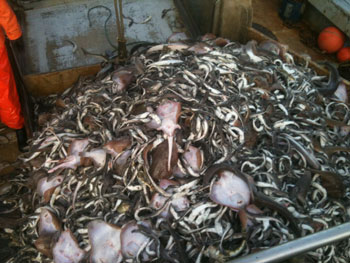Dogfish Sustainable and Out of Control
by Fishermen’s Voice Staff

Baby spiney dogfish caught in an area off Block Island, R.I. in February, 2012. Here 50,000 baby dogfish were caught in 18 minutes of bottom tow time. Researchers were using 6 1/2" diamond mesh net that was plugged with dogfish. Dogfish live 30 to 40 years and grow from 3 to 4 feet in length. Dr. James Sulikowsky Photo.
Dogfish, federally protected since 1996, have recently received Marine Stewardship Certification (MSC). That certification, based on current scientific research, means the stock is rebuilt and is being sustainably fished. During most of the 16 years dogfish have been federally protected fishermen have complained that the dogfish stock has grown to be a menace to the other protected species in the Gulf of Maine.
Fishermen, scientists and managers have asked how there could be such a wide gap between the science and the reality in the water. Dr. James Sulikowski, a marine biologist at the University of New England, has done research that has put answers in that information gap.
Maine fisherman Mike Bretton said, “this is the best news in 50 years.” Bretton and a handful of other New England fishermen have for years been actively attempting to get management to listen to what they have been saying about the enormous population of dogfish in the Gulf of Maine. Bretton said he has caught tuna that were two thirds eaten by masses of dogfish by the time he hauled the tuna to his boat.
Sulikowsky has found that the science used to establish the federal rebuilding plan was very outdated and woefully inadequate. He found that unlike most fish that spawn annually the dogfish produce eggs and pups continuously. Unlike female sharks that breed at the same time of year and all give birth the next June, dogfish carry their young for two years and bear live 8” long fish (pups) 4 to 6 at a time. At the same time they are carrying fish in various states of development. This means they are giving birth to 8” fish all year that immediately begin eating.
He will be doing a presentation at science conferences this fall on his dogfish findings.
Sulikowsky was towing in what his group believed was a dogfish pupping ground in an area off Block Island, R.I. in February, 2012. He said they caught 50,000 dogfish in 18 minutes of bottom tow time. They were using 6 1/2” diamond mesh net that was plugged with young dogfish. This was in an area, he said, where dogfish were not supposed to be.
The dogfish has changed said Sulikowski. Their reproduction seems more plastic. They are reproducing at a younger age, they are becoming regional and therefore staying year round and competing for food. But, he said, most of the research is being done on cod and other high value fish, while dogfish are ignored.
Dogfish are also not subject to other biological limits governing the fish they prey upon. Most groundfish inhabit waters with a temperature range of a few degrees. Dogfish can operate in water temperatures from zero to 30 degrees Celsius. Most fish return to traditional spawning areas. Dogfish give birth wherever they happen to be.
A New Bedford Massachusetts group applied for MSC approval of the dogfish in search of an unbiased look at the status of the stock and an approach to the management process in order to make changes in how dogfish are managed.
Sulikowski’s dogfish research has shed light on the management process and it’s reliance on comparatively meaningless scientific data. It also supports the credibility of the disparity between what fishermen see every day on the water and what is driving management decisions.
The dogfish is not new to New England waters, nor is the problem it has presented to fishermen. Edward Prince, a Canadian marine biologist described the dogfish as a plague in the early 1900’s. Bigelow and Schroeder’s, Fishes of the Gulf of Maine, considered “the” book on the fish of the Gulf of Maine, is based on research begun in the late 1920’s and was first published in 1953, describes dogfish as ferocious beyond belief. Dogfish are more mobile, inhabit many different locations, they can live more off the bottom and follow juvenile fish.
Sulikowski said, “We need to seek ecosystem balance. NOAA is working hard, but we are stuck in single species management. We need to act now. We can’t blame the fisheries collapse on fishermen. There is more predation and one of those predators is the dogfish.”
Dogfish were fished hard here in the 1980’s and 1990’s. Major markets included British fish and chips outlets and Germany. That fishing lowered the stocks and restrictions came in under the Magnuson- Stevens Act in 1996. The predicted recovery date for the stock in 1996 was 2020. However, it is now believed to have recovered in 2009.
The MSC findings offer a new opportunity for dogfish in commercial markets around the world. The question is how soon can a slow moving, cumbersome federal bureaucracy respond to a fast moving crisis.
